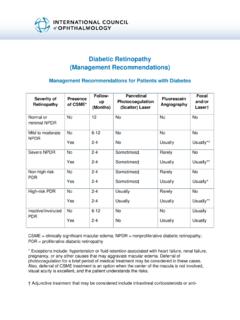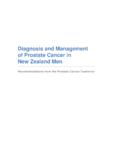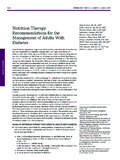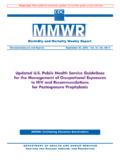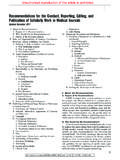Transcription of EULAR evidence based recommendations for the …
1 Downloaded from on 22 August 2007. EULAR evidence based recommendations for the management of fibromyalgia syndrome S F Carville, S Arendt-Nielsen, H Bliddal, F Blotman, J C Branco, D Buskilla, J AP Da Silva, B Danneskiold-Sams e, F Dincer, C Henriksson, K Henriksson, K Kosek, K. Longley, G M McCarthy, S Perrot, M J Puszczewicz, P Sarzi-Puttini, A Silman, M. Sp th and E H Choy Ann Rheum Dis published online 20 Jul 2007;. Updated information and services can be found at: These include: Rapid responses You can respond to this article at: Email alerting Receive free email alerts when new articles cite this article - sign up in the box at the service top right corner of the article Notes Online First contains unedited articles in manuscript form that have been peer reviewed and accepted for publication but have not yet appeared in the paper journal (edited, typeset versions may be posted when available prior to final publication).
2 Online First articles are citable and establish publication priority; they are indexed by PubMed from initial publication. Citations to Online First articles must include the digital object identifier (DOIs) and date of initial publication. To order reprints of this article go to: To subscribe to Annals of the Rheumatic Diseases go to: Downloaded from on 22 August 2007. ARD Online First, published on July 20, 2007 as EULAR evidence based recommendations for the management of fibromyalgia syndrome S. F. Carville1, L. Arendt-Nielsen2, H. Bliddal3, F. Blotman4, J. C. Branco5, D. Buskila6, J. A. P. Da Silva7, B. Danneskiold-Sams e3, F. Dincer8, C. Henriksson9, K. G. Henriksson10, E. Kosek11, K. Longley12, G. M. McCarthy13, S. Perrot14, M. Puszczewicz15, P. Sarzi-Puttini16, A. Silman17, M. Sp th18, E. H. Choy1. Corresponding address: Dr Serena Carville, 1 Sir Alfred Baring Garrod Clinical Trials Unit, Academic Rheumatology Unit, King's College London, Weston Education Centre, Cutcombe Road, London, SE5 9RJ, United Kingdom.
3 , email: 2. Aalborg University, Center for Sensory-Motor Interaction, Department of Health Sciences and Technology, Denmark. 3. The Parker Institute, Frederiksberg Hospital, Copenhagen, Denmark. 4. Rheumatology Department, Hospital Lapyeronie, Montpellier, France. 5. Servi o de Reumatologia, Hospital Egas Moniz, Centro Hospitalar Lisboa Ocidental, Lisbon, Portugal. 6. Department of Medicine, Soroka Medical Center, Beer Sheva, Israel. 7. Reumatologia, Hopitais Da Universidade, Coimbra, Portugal. 8. Department of Physical and Rehabilitation Medicine, Hacettepe Medical School, Ankara, Turkey. 9. INR, Section of Occupational Therapy, Faculty of health sciences, Link ping University, S-581 85 Link ping, Sweden 10. Neuromuscular Unit, University Hospital, Linkoping. 11. Department of Clinical Neuroscience, Karolinska Institute, Stockholm, and Stockholm Spine Center, L wenstr mska Hospital, Upplans V sby, Sweden.
4 12. Bath, United Kingdom. 13. Rheumatology, Mater Misericordiae University Hospital, Dublin, Ireland. 14. Pain Clinic, Hospital Cochin, Paris, France. 15. Department of Rheumatology, Rehabilitation and Internal Medicine University of Medical Sciences, Poznan, Poland 16. Rheumatology Unit, L. Sacco University Hospital, Milan, Italy, 17. Faculty of Medical and Human Sciences ARC Epidemiology Unit, The University of Manchester, Manchester, United Kingdom, 18. Bahnhofstr. 95 82166 Graefelfing, Germany The Corresponding Author has the right to grant on behalf of all authors and does grant on behalf of all authors, an exclusive licence (or non exclusive for government employees) on a worldwide basis to the BMJ Publishing Group Ltd to permit this article (if accepted) to be published in ARD and any other BMJPGL products and sublicences such use and exploit all subsidiary rights, as set out in our licence ( ).
5 ". Keywords: EULAR , fibromyalgia, management , systematic review Word count: 3012. 1. Copyright Article author (or their employer) 2007. Produced by BMJ Publishing Group Ltd (& EULAR ) under licence. Downloaded from on 22 August 2007. ABSTRACT. Objective: To develop evidence based recommendations for the management of fibromyalgia syndrome (FMS). Methods: A multidisciplinary task force was formed representing eleven European Countries. The design of the study including search strategy, participants, interventions, outcome measures, data collection and analytical method was defined at the outset. A systematic review was undertaken with the keywords fibromyalgia', treatment or management ' and trial'. Studies were excluded if they did not utilise the ACR classification criteria, were not clinical trials, or included patients with chronic fatigue syndrome or myalgic encephalomyelitis.
6 Primary outcome measures were change in pain assessed by visual analogue scale (VAS) and fibromyalgia impact questionnaire (FIQ). The quality of the studies was categorised based on randomisation, blinding and allocation concealment. Only the highest quality studies were used to base recommendations on. When there was insufficient evidence from the literature, a Delphi process was used to provide basis for recommendation. Results: One hundred and forty six studies were eligible for the review. Thirty nine pharmacologic intervention studies and 59 non-pharmacologic were included in the final recommendation summary tables once those of a lower quality or with insufficient data were separated. The categories of treatment identified were antidepressants, analgesics, and other pharmacological' and exercise, cognitive behavioural therapy, education, dietary interventions and other non- pharmacological'.
7 In many studies sample size was small and the quality of the study was insufficient for strong recommendations to be made. Conclusion: Nine recommendations for the management of FMS were developed using a systematic review and expert consensus. 2. Downloaded from on 22 August 2007. INTRODUCTION. Fibromyalgia syndrome (FMS) is a common rheumatologic condition characterised by chronic widespread pain and reduced pain threshold, with hyperalgesia and allodynia. Associated features include fatigue, depression, anxiety, sleep disturbance, headache, migraine, variable bowel habits, diffuse abdominal pain and urinary frequency [1][2]. Although the precise pathogenesis remains unknown, peripheral and central hyperexcitability at spinal or brainstem level [3][4][5], altered pain perception [6] and somatisation [7][8] have been hypothesised and demonstrated in some patients.
8 The American College of Rheumatology (ACR) classification criteria for FMS [9] are the most commonly used in clinical and therapeutic research. The healthcare utilisation by patients with FMS is high averaging over $2000 per patient per year [10], but it has been shown that positive diagnosis and management can reduce healthcare utilisation [11]. Although effective treatments are available [12][13][14] no guidelines exist for management of FMS. The objectives were to ascertain the strength of the research evidence on effectiveness of treatment of FMS and develop recommendations for its management based on the best available evidence and expert opinion to inform healthcare professionals. METHODS. Participants A multidisciplinary taskforce was formed consisting of 19 experts in FMS. representing eleven European Countries. Search strategy A systematic search of Medline, PubMed, EmBASE, PsycINFO, CINAHL, Web of Sciences, Science Citation Indices, Cochrane Central Register of Controlled Trials and Cochrane Database of Systematic Reviews using the key words: fibromyalgia , treatment or management and trial for all publications till the end of December 2005 was carried out.
9 A manual search of the bibliographies of trials was undertaken to verify that all published trials were identified. Inclusion criteria Included studies had to be clinical trials using the American College of Rheumatology 1990 classification criteria for FMS [9] to select patients. Studies including patients with Chronic Fatigue Syndrome or Myalgic Encephalomyelitis, were excluded unless they were divided into separate comparator groups for analysis. Assessment of literature A checklist' method [15] was used to assess quality of each study. Data was tabulated using a customised data-extraction form. This included number of patients in each arm, randomisation and blinding status. Previous reviews have identified two main outcome measures: pain assessed by visual analogue scale (VAS) and function 3. Downloaded from on 22 August 2007. assessed by the Fibromyalgia Impact Questionnaire (FIQ) [16][17].
10 The main measure of effect was the between group difference calculated from the mean change between the pre- and post- treatment values in these outcome measures. Where possible, effect size for the best' treatments in each category was calculated (averaged if there was more than one trial). Rosnow and Rosenthal's modified version of the Cohen's d calculation was used [18]. The thresholds used for interpretation were: values > = small, > = medium and > = large. The number needed to harm (NNH) was also calculated if possible, using withdrawal due to adverse event as the event. Additional information included; recruitment population; duration of disease, treatment and assessment; number of tender points;. and myalgic score. Other outcome measures considered were also tabulated. If required data were recorded, but not presented, or not presented in a suitable format, the author was contacted wherever possible.
